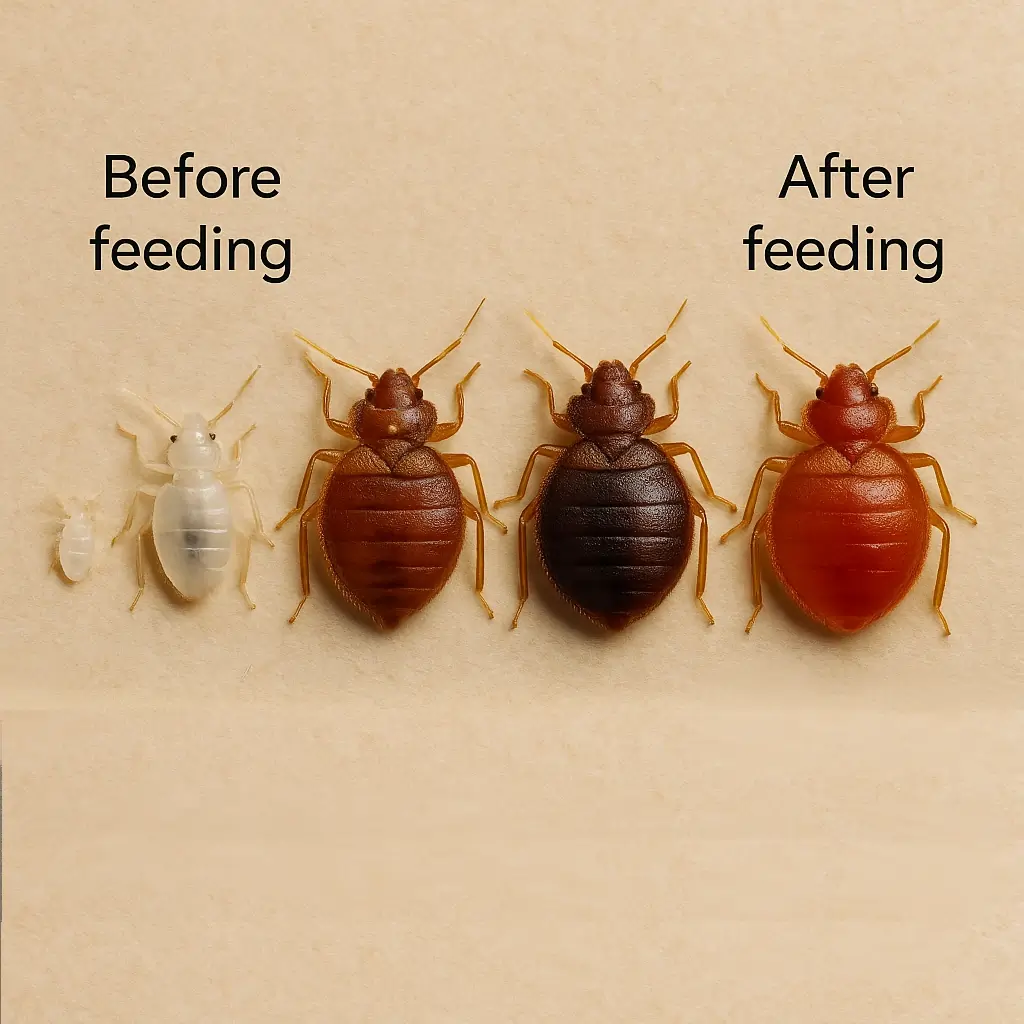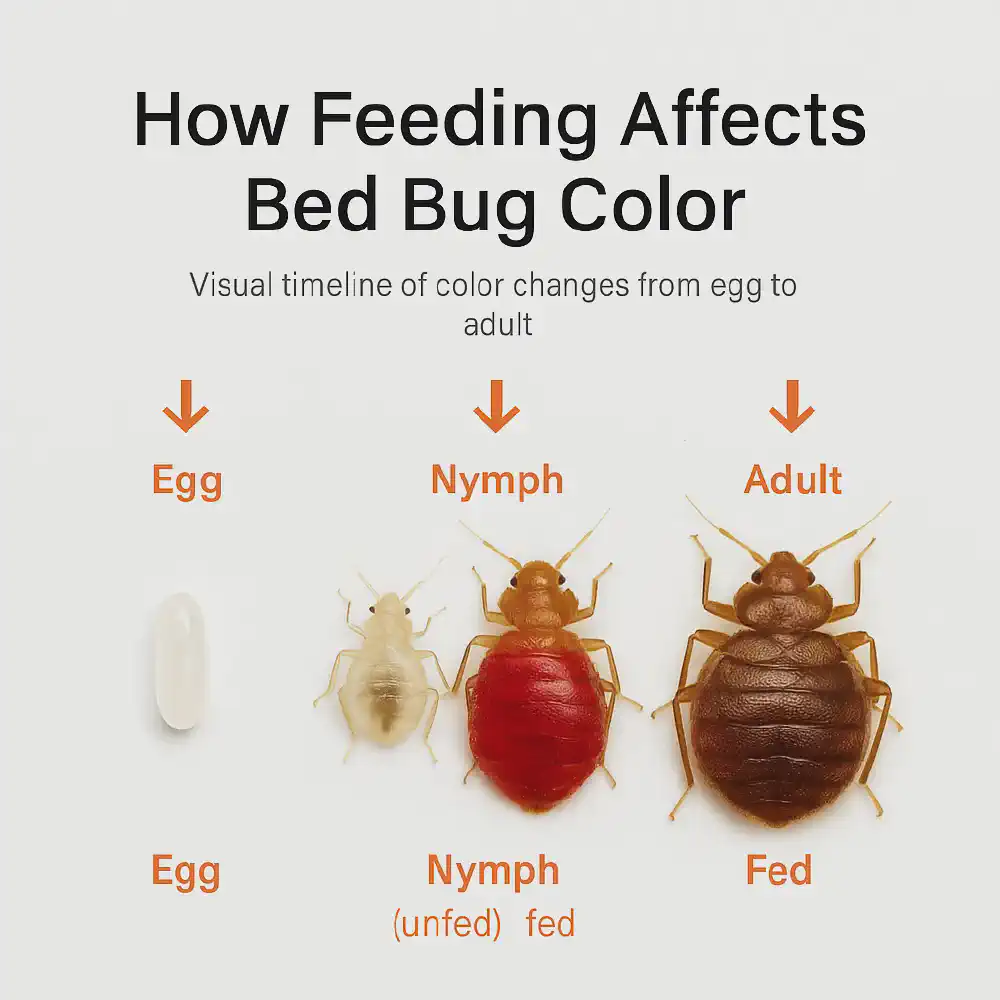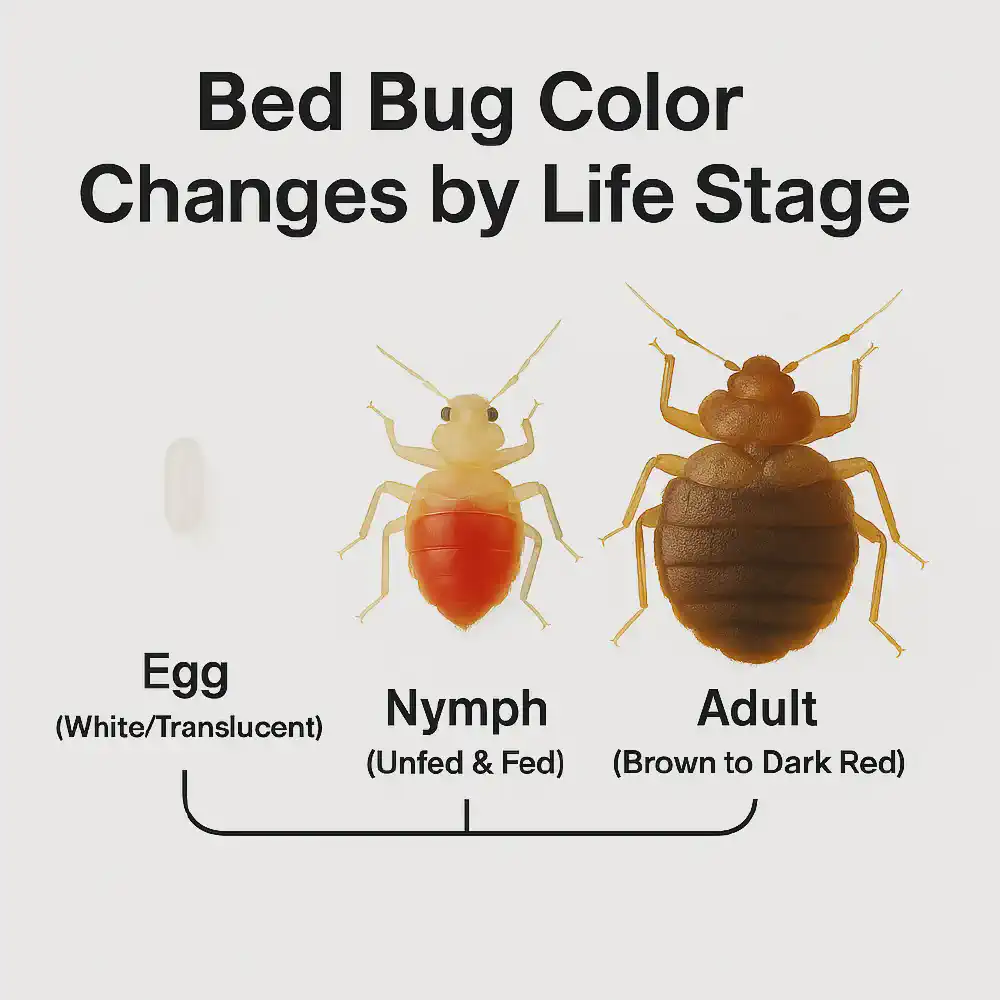
What Color Are Bed Bugs?
What color are bed bugs? Learn how their color changes across life stages to identify them quickly and accurately.
Not Sure What Color Bed Bugs Really Are?
Don’t spend hours comparing photos online — upload a picture of what you found, and our AI instantly tells you if it’s a bed bug.
Just Want a Straight Answer?
Skip the guessing — our analyzer matches your photo against verified bed bug colors so you’ll know within a minute.
If you’ve spotted a strange insect and aren’t sure if it’s a bed bug, you can upload a photo to our free detection tool. Our expert system will analyze the image and let you know if it’s a bed bug — so you can take the right next steps confidently.
Table of Contents
- What Color Are Bed Bugs?
- Color by Life Stage
- How Feeding Affects Bed Bug Color
- Unusual Bed Bug Colors Explained
- Identifying Bed Bugs by Color
- FAQ
- Summary
What Color Are Bed Bugs?
The color of bed bugs depends largely on their age and whether they’ve recently fed. Adult bed bugs are generally a reddish-brown color — often described as similar to an apple seed. But color alone can vary considerably and may cause confusion with other insects.
Color by Life Stage

Understanding what color bed bugs are throughout their lifecycle is key to accurate identification:
- Eggs: Pearly white or translucent, about 1mm in size. Difficult to spot on light surfaces.
- First stage nymphs: Almost transparent or white. After feeding, they may appear bright red.
- Later-stage nymphs: Light brown to tan, darkening as they feed and grow.
- Adults: Typically mahogany or rusty brown when unfed. After feeding, they take on a deeper red-brown color.
Want to see how each stage actually looks?
What bed bugs look like to the human eye includes zoomed images of nymphs, adults, and eggs to help you recognize them at a glance.
Think You Saw a White or Red Bug?
Upload a photo — our AI identifies the bug and tells whether that translucent or red insect is actually a bed bug nymph.
Still Comparing Colors?
White, red, brown, or translucent — we’ll confirm the truth in seconds. No need to guess.
How Feeding Affects Bed Bug Color

One of the most dramatic color changes in bed bugs happens right after feeding. Their bodies become engorged with blood, turning a bright or deep red. This is especially noticeable in younger nymphs, where the red appears stark against their otherwise pale bodies.
Unfed bed bugs, in contrast, may appear more tan or brown. This shift can make it harder to identify them if you’re expecting a specific hue.
Unusual Bed Bug Colors Explained
Not every bug you see is a bed bug, even if the color looks similar. Here are common misconceptions:
- Are bed bugs red in color? Yes, after feeding. Otherwise, adults are more of a reddish-brown.
- Are bed bugs white in color? Nymphs can appear nearly white before feeding, especially in their first stage.
- Can bed bugs be white in color? Only in early nymph stages or immediately after hatching.
- Bed bug color black: Bed bugs are not truly black. However, dead bed bugs or their fecal spots may appear very dark or black.
- Can bed bugs be black in color? No, living bed bugs are never black. Dark brown may appear close, but black bugs are usually something else.
- Green bed bug: There are no known green bed bugs. If you’ve seen a green insect in your bed, it’s likely another species.
- Orange bed bugs: Some lighting may make nymphs or unfed adults appear orange or tan, but this is rare.
- Do bed bugs look like ants? Learn the key differences in our full guide on do bed bugs look like ants.
- Baby bed bugs: Many wonder what do baby bed bugs look like — they start translucent white and turn red after feeding.
If you’re unsure what you’ve found, color alone can be misleading. Use our free tool to be certain.
Think you’ve found bed bugs? Upload a photo with our free detection tool. If confirmed, we’ll email you a personalized treatment plan — complete with everything you need to eliminate them.**
Color Alone Isn’t Enough — Let AI Confirm It
Upload any photo — our system analyzes shape, color, and pattern to confirm if it’s a bed bug, instantly.
Stop Wondering and Know for Sure
Don’t keep second-guessing what you saw. Upload a quick photo — we’ll verify it in seconds.
Identifying Bed Bugs by Color

Visual inspection is one of the fastest ways to detect a bed bug problem. Use color as a primary indicator, but combine it with other traits:
- Shape: Flat and oval
- Size: Adults are about 5–7mm (¼ inch), nymphs are smaller
- Location: Found in seams of mattresses, furniture crevices, or behind baseboards
- Other signs: Red stains (from crushed bugs), dark fecal spots, shed skins
Need more than just color? Read our detailed guide to bed bug identification for visual comparisons, signs, and what to look for in different environments.
If you’ve spotted a small red bug in bed or noticed red bugs in the bedroom, it could be a fed bed bug. Always take a closer look — or better yet, snap a photo and let us analyze it for you.
Frequently Asked Questions
Can bed bugs be different colors?
Yes, bed bugs range from nearly white as eggs to reddish-brown as adults. After feeding, their bodies can appear bright red.
Are all red bugs in the bedroom bed bugs?
No. While red bed bugs are common after feeding, not all red bugs are bed bugs.
What does a white bed bug mean?
A white bed bug is most likely a young nymph that hasn’t fed yet.
Can bed bug bites be confused with other bites?
Yes, especially ant or flea bites. Learn how to recognize patterns in our guide on bed bug bites.
Summary
So, what color are bed bugs? The answer depends on their age and feeding status. Eggs are white, nymphs are pale or yellowish, and adults are brown to reddish-brown. After feeding, bed bugs often appear redder. This spectrum of colors can sometimes cause confusion with other insects. Color is one clue — but don’t miss others. Our expert guide to identifying potential bed bug infestations guide to identifying potential bed bug infestations shows you everything to look for before things get worse.
By knowing the visual traits of bed bugs and how their color changes over time, you can better identify them early — before a full infestation develops. Use our free photo detection tool if you’re unsure. It’s quick, accurate, and the first step toward peace of mind. Wondering if they’re still around even if you haven’t seen them lately? Learn how long bed bugs can live without a host — the survival window may surprise you.
Worried About Bed Bugs? Find Out Now – For Free!
Upload a picture and get instant, free detection. No guessing—just fast, accurate results. If bed bugs are found, we’ll recommend the right products and simple step-by-step treatment.
Click here to start – it’s 100% free!
Get started nowWorried About Bed Bugs? Find Out Now – For Free!
Upload a picture and get instant, free detection. No guessing—just fast, accurate results. If bed bugs are found, we’ll recommend the right products and simple step-by-step treatment.
Click here to start – it’s 100% free!
Get started now